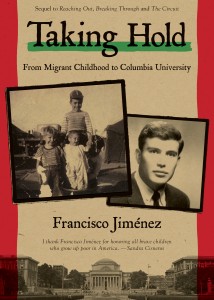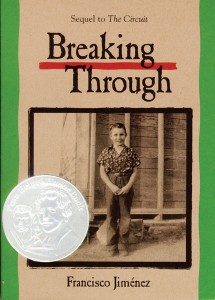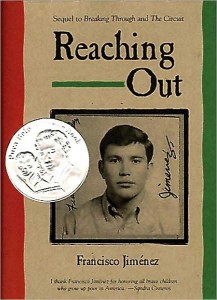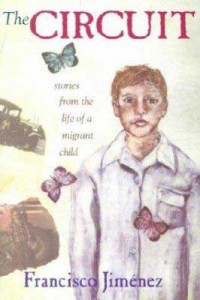TeachingBooks.net is delighted to welcome award-winning author Francisco Jiménez as our featured guest blogger.
Each month, we ask one distinguished author or illustrator to write an original post that reveals insights about their process and craft. Enjoy!

“Taking Hold: The Transformational Power of Education”
by Francisco Jiménez
Over the years, I’ve received numerous letters and emails from readers telling me how much they enjoy reading my work; they have also expressed interest in knowing more about my family. And touring and presenting, the questions I’m most frequently asked include: How can you remember so many details about the past? When did you start writing? What motivates you to write? What is the most important thing readers can learn from reading your work?
 Taking Hold
Taking Hold
Encouraged by my readers and my wonderful editor, Ann Rider, I wrote Taking Hold: From Migrant Childhood to Columbia University (HMH, 2015), the fourth book in my memoir series. In Taking Hold, I relate memorable and life-changing experiences I had living in New York City while attending Columbia University. Focusing on the transformational power of education, I recount the intellectual, emotional, and psychological impact of my studies on my sense of self, the challenges I faced in completing my formal education, and my efforts to find stability and purpose in my personal and professional life during an era marked by social and political unrest. Interwoven in the narrative is what life was like for me as a child growing up in a family of Mexican migrant workers.
Remembering the Past
 Before I begin writing, I do lots of research connected to the experiences I plan to write about. For The Circuit (University of New Mexico Press, 1997), Breaking Through (2001), and Reaching Out (both HMH, 2008), I interviewed family members and friends; looked at family pictures, school yearbooks, and report cards; read school newspapers; and visited places, such as the migrant camps, where my family lived as we followed seasonal crops. For Taking Hold, I went back to Columbia University and spent time there taking photographs, walking around campus, going to the library, and reading archival material that dealt with the period of time I spent in graduate school, including the Columbia University Riots.
Before I begin writing, I do lots of research connected to the experiences I plan to write about. For The Circuit (University of New Mexico Press, 1997), Breaking Through (2001), and Reaching Out (both HMH, 2008), I interviewed family members and friends; looked at family pictures, school yearbooks, and report cards; read school newspapers; and visited places, such as the migrant camps, where my family lived as we followed seasonal crops. For Taking Hold, I went back to Columbia University and spent time there taking photographs, walking around campus, going to the library, and reading archival material that dealt with the period of time I spent in graduate school, including the Columbia University Riots.  I also read copious letters that I wrote to and received from family and my correspondence with friends, teachers, and colleagues at Columbia. I describe events from the perspective of the young adult I was then, making use of my powers of imagination and invention to approximate or create dialogue and to fill in small details that I have forgotten. I read each piece or chapter out loud to make sure I have maintained the same voice throughout. (The Circuit is written from the child’s point of view; Breaking Through is that of the teenager, and Reaching Out from a young adult’s point of view.)
I also read copious letters that I wrote to and received from family and my correspondence with friends, teachers, and colleagues at Columbia. I describe events from the perspective of the young adult I was then, making use of my powers of imagination and invention to approximate or create dialogue and to fill in small details that I have forgotten. I read each piece or chapter out loud to make sure I have maintained the same voice throughout. (The Circuit is written from the child’s point of view; Breaking Through is that of the teenager, and Reaching Out from a young adult’s point of view.)
The Genesis of My Work

The genesis of Taking Hold and my other works goes back to the time when I read The Grapes of Wrath (Penguin, 1939) as a sophomore in high school. For the first time, I realized that my own story, as well as the story of other Mexican migrant workers, was part of the American story. I understood the power of words to move hearts and minds, the power of literature to change lives. Then, when I went to college, I quickly discovered that my experiences growing up in a family of migrant workers were an obstacle and a blessing. They were an obstacle to the extent that I did not have the social, economic, and educational advantages that most of my classmates enjoyed; they were a blessing because they served as a reminder of how fortunate I was to be in college. Whenever I felt discouraged, I would write down childhood memories to give me the courage to continue. Those recollections served me well. When I felt dispirited, I turned to them for courage and strength.
 Following the advice of Professor Iduarte, my graduate thesis advisor, to write and publish my stories, I gathered my notes and wrote “La mudanza” (“The Move”), which I expanded and titled “Cajas de carton” (“Cardboard Boxes”). I translated it into English under the title “The Circuit” and it was published in the Arizona Quarterly in 1973. After that year, I spent most of my time teaching and doing scholarly research and administrative work. It was not until my sabbatical in 1995 that I resumed writing systematically.
Following the advice of Professor Iduarte, my graduate thesis advisor, to write and publish my stories, I gathered my notes and wrote “La mudanza” (“The Move”), which I expanded and titled “Cajas de carton” (“Cardboard Boxes”). I translated it into English under the title “The Circuit” and it was published in the Arizona Quarterly in 1973. After that year, I spent most of my time teaching and doing scholarly research and administrative work. It was not until my sabbatical in 1995 that I resumed writing systematically.
Motivation and Purpose for Writing
I write to chronicle my family’s history, but more importantly, to give voice to the experiences of a large sector of our society that is frequently ignored. Through my writing I hope to give readers an insight into the lives of Mexican immigrants, some of whom are migrant farm workers, whose courage, struggles, and hopes and dreams for a better life for their children and their children’s children give meaning to the expression the American dream. Their story is an important and integral part of the American story.
Lessons Learned
During the time my family moved from place to place following seasonal crops, I yearned for stability. My search for a permanent home, in large part, came out of a desire to attend school without interruption. I hated missing two and a half months of school every year and finding myself way behind in my studies. Even though school was difficult for me, especially English class, I enjoyed learning. I found permanence in education—whatever I learned in school and on my own went with me no matter how many times we moved. It was mine to have and to hold. Education transformed my life. It’s not surprising that I have the greatest respect and gratitude for teachers and have devoted most of my professional life to teaching and promoting literacy and education.


Leave a Reply